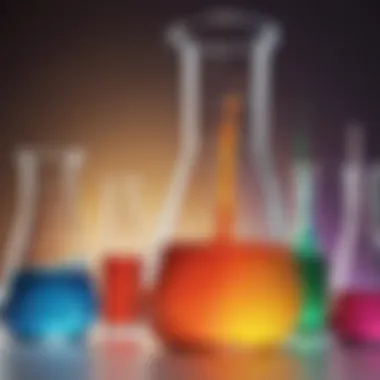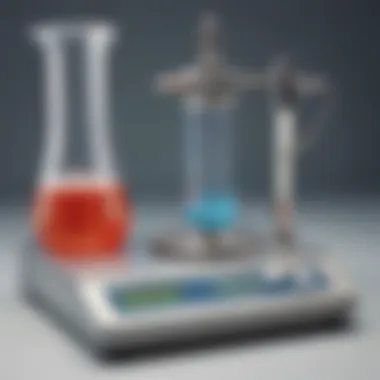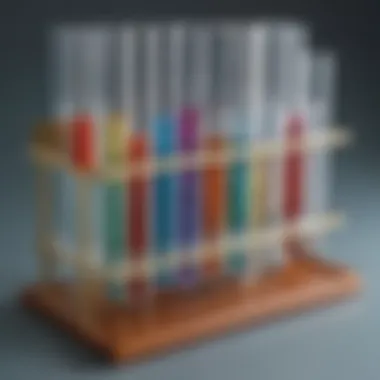Understanding Chemistry Lab Equipment for Young Scientists


Intro
In this guide, we explore the essential world of chemistry lab equipment. Understanding this equipment is crucial for young scientists enthusiastic about exploring chemistry. Each instrument serves a unique purpose, wasting time only if incorrectly used.
Chemistry is the study of matter and its changes. Having the right tools helps budding scientists conduct experiments effectively. Throughout this comprehensive examination, we will delve into various lab instruments, their functions, and rules for safe handling. Developing a strong foundation in chemistry lab practices can inspire innovation and discovery in young learners.
Science Fun Facts
Every subject has interesting aspects that spark curiosity. Chemistry is no exception. Let's examine some engaging facts that invite interest in this field:
- Alchemists of the Past: Before modern chemistry existed, scientists pursued alchemy, desperate to turn lead into gold. They aimed for a substance that granted eternal life called the Philosopher's Stone.
- Atoms and More: Did you know more than a trillion atoms can fit on the head of a pin? This numerical magnitude illustrates how tiny atoms are relative to other objects.
- Photographs in Chemistry: The famed artist Ansel Adams developed stunning black-and-white photographs using the same chemical principles seen in chemistry labs!
“Chemistry is the bones of science. Without it, we wouldn’t understand the reactions that govern our universe.”
Additionally,
- Some chemicals explode when combined, making science both fun and dangerous.
- Ice cubes float in water due to the unique properties of hydrogen bonding.
Understanding these facts enriches students' knowledge and encourages inquisitive minds to dig deeper.
Discover the Wonders of Science
Chemistry relates to various scientific concepts that extend beyond standard classroom boundaries. The integration of these is vital for fostering genuine interest in scientific inquiry:
- Educational Videos and Animations: Visual aids simplify understanding tricky ideas, such as chemical reactions and lab equipment function, making them accessible.
- Interactive Learning Tools: Online platforms provide simulations. Students can conduct virtual experiments, helping grasp difficult concepts comprehensively.
- Real-Life Applications of Science: Understanding chemistry showcases its relevance. Knowledge translates to cooking, cleaning, and many daily activities that require chemical understanding for safe and effective use.
Science Quiz Time
Encouraging self-assessment through quizzes reinforces learning. Consider contemplating the following:
- What can you measure with a graduated cylinder?
a. Temperature
b. Liquid volume
c. Gas pressure - Which of the following is necessary for all chemical reactions?
a. A catalyst
b. Light
c. Reactants
Reflecting on questions like these solidifies knowledge of lab equipment functions and uses.
Science Experiment Showcase
Conducting simple, safe chemistry experiments is a fun way to apply knowledge. Here is one that reinforces learning about acids and bases:
Materials List:
- Vinegar
- Baking soda
- A clear container
Step-by-Step Instructions:
- Pour a small amount of vinegar into the container.
- Add a spoonful of baking soda into the vinegar.
- Watch the reaction bubbles form.
Safety Tips:
- Always conduct this experiment in a well-ventilated area.
- Use goggles to protect eyes from splashes.
- Ensure to clean up all residues afterward.
Experiments like these captivate curiosity while solidifying fundamental chemical concepts. Encouragement comes from hands-on experiences and creates future opportunities.
Emerging scientists can embrace knowledge and creativity by reviewing this guide to transforms their understanding of chemistry.
Prelude to Chemistry Lab Equipment


Chemistry lab equipment is the backbone of any successful experiment. Understanding how to use these tools effectively is crucial for anyone interested in science, especially young learners eager to explore the chemical world. This guide highlights not only what these tools are but also their functions, advantages, and contexts in which they are employed.
Importance of Chemistry Lab Equipment
Knowing about chemistry lab equipment is important for several reasons. First, it helps students feel confident in a lab setting. When young scientists recognize the tools and are aware of their functions, they can perform experiments with greater ease and understand results more effectively. Furthermore, using the correct equipment is paramount for safety. Items like safety goggles and lab coats protect experimental enthusiasts from accidental spills or reactions, reducing hazards.
Moreover, certain equipment can impact the quality of experiments and outcomes. For instance, proper measurement tools such as balances and pipettes ensure that experiments are accurate, contributing to reliable data gathering. Engaging with chemistry lab equipment not only fuels curiosity but also lays the foundation for future scientific endeavors. Young learners stand to gain valuable hands-on experience, which advances their education in science.
Overview of Common Tools
A variety of tools changes each chemistry lab into an experimental hub. Below are some common tools that one might encounter:
- Glassware: Includes beakers, flasks, and test tubes. Each item has its purpose in holding, measuring, or mixing chemicals.
- Measurement Instruments: Tools like graduated cylinders and pipettes ensure precise measurement, critical for experiments.
- Heating Apparatus: Bunsen burners and hot plates are used to heat substances safely.
- Safety Equipment: Essential items such as safety goggles and lab coats protect young scientists while experimenting.
Recognizing these tools and understanding their roles is an invaluable skill for any budding scientist. Young learners can look forward to increasing their knowledge as they delve deeper into each specific picture of lab equipment throughout this guide. Each tool plays a role, contributing to the overall realm of chemistry.
Glassware Essentials
Glassware is a crucial component found in any chemistry lab. This section highlights the different types and functions of glassware, making it easier for young scientists to understand their use in experiments. In addition, understanding glassware can foster confidence and competence in conducting experiments safely and effectively.
Beakers
Definition and Use
Beakers are multi-purpose glass containers used for mixing, heating, or holding liquids. They typically have a spout for easy pouring. Beakers are highlighted for their simplicity and versatility. Their design includes graduated markings that allow for measurement of volume. This quality makes them popular in classrooms and labs alike. Also, they are useful for various applications like stirring solutions or making observations. However, they are not always precise in terms of volume measurement, which can be a disadvantage in experiments requiring high accuracy.
Different Sizes and Materials
Beakers come in various sizes, ranging from small 50 milliliters to large volumes such as 5 liters. The main materials for beakers are glass and plastic, each serving different needs. Glass beakers are ideal for high-heat situations, while plastic ones are more durable and less fragile. Depending on the size and material, each type has its own strengths and weaknesses. Plastic beakers are lightweight and are less likely to break during spills, yet glass beakers provide better chemical resistance.
Flasks
Flasks are glass vessels designed primarily for containing and reacting liquids. Their narrowing necks help minimize evaporation and facilitate mixing.
Erlenmeyer Flasks
Erlenmeyer flasks are easily identified by their conical shape. This design gives them stability, allowing for effective mixing without spillage. They are vital for experiments requiring swirling without inducing evaporation. The wide base gives enough surface area for reactions, while the narrow neck contains no splash over. However, their shape limits precise volume measurement, unlike cylindrical glassware.
Volumetric Flasks
Volumetric flaks are used specifically for making accurate liquid measurements. They have a defined volume, marked clearly on the neck. Their shape is distinctively narrow at the top, allowing accurate liquid filling to a specific line. This feature is especially beneficial when measuring solutions for concentration. Nevertheless, they cannot be used for boiling any liquid as the thin glass could shatter under heat.
Test Tubes
Test tubes are probably among the most recognizable glassware in science. They are used for small scale reactions and sample assessments.
Uses of Test Tubes
Test tubes serve multifunctional purposes. They can hold small volumes of liquids for reactions or precise weighing of solids. Their design allows young scientists to visually monitor reactions rather than utilizing complex machines. However, because they are small and shallow, control over measurements is likewise limited. This can complicate certain aspecst of science experimentation.
Test Tube Racks
Test tube racks are essential for holding and organizing test tubes securely. They have slots to fix tubes upright, preventing spills or breakage. This basic tool is pivotal in maintaining a safe and tidy workspace. The availability of racks in various sizes allows for accommodating different lab setups. Yet, if cluttered with too many tubes, they can take up substantial bench space in any given laboratory.
Glassware is foundational for countless experiments, laying the groundwork for deeper scientific understanding. A solid grasp of these tools sets young scientists on the path to successful exploration.


Measurement Instruments
Measurement instruments are critical parts of any chemistry lab. They help scientists precisely measure substances needed for experiments. Accuracy in measurements greatly influences the outcome. Young scientists who learn to use these instruments are better equipped for experimentation and understanding chemical reasoning.
Graduated Cylinders
Graduated cylinders play a significant role in accurately measuring liquid volumes. Their clear, tall structure allows students to get precise readings. For beginners, these instruments are particularly user-friendly. The addition of graduation marks indicates different volume levels, which can help avoid any errors in the readings.
Purpose and Accuracy
The primary purpose of graduated cylinders is to ensure exact measurements of liquids. Precision is key in any scientific process, as even a slight error can result in different outcomes. Graduated cylinders are valuable because their design minimizes meniscus effects, which refers to the curve seen at the surface of the liquid. This characteristic ensures that students get reliable and accurate results from their experiments.
Variations of Design
Graduated cylinders come in multiple designs. They might differ in height, diameter, and material type. These variations serve specific user cases. For instance, a taller cylinder might be preferable in measuring larger volumes, while a smaller version can be beneficial when working with limited samples. Each design improvement ensures more precise accuracy for particular tasks, making them integral tools in a lab setting.
Pipettes
Pipettes are indispensable for transferring liquids in small amounts and also for measurements. Particularly in experiments that require precision, these instruments can transform the outcomes. As such, a sound understanding of pipettes is crucial for budding scientists.
Types of Pipettes
There are different types of pipettes, each tailored for distinct needs. Common types include volumetric pipettes, which have a single, precise measurement. Another type is a bulb pipette, which allows for multiple measurements. Using specific types in differing situations improves efficiency and accuracy in data collection. Understanding the benefits of each type makes it easier for students to choose the right pipette for their experiments.
Proper Usage Techniques
Correct use of pipettes is essential to achieve accurate results. First, the user should always ensure the pipette is clean. The process must include checking the calibration. When using a pipette, inserting the tip to the right depth can influence measurement accuracy. Therefore, teaching students these techniques helps enhance reliability in measurement throughout their scientific journey.
Balances
Balances are devices that measure mass with high levels of accuracy. They often present a comparison of the weight of an object against standardized weights. Their usage is fundamental in chemistry labs, as precise mass measurement contributes to better formulation of reactions.
Types of Balances
Several types of balances exist, including analytical balances and top-loading balances. Analytical balances provide high precision and are suited for smaller quantities. Consequently, students need familiarity with both to decide which one fits their experiment needs best. Moreover, the adaptability of balances across various labs highlights their importance.
Importance of Precision
Precision in measurements directly affects the results of any scientific endeavor. A simple weight shift on a regular scale can lead to significant errors. Education about the importance of using precise balances can ensure that young scientists appreciate and implement accuracy into their work.
Key takeaway: Understanding and using measurement instruments diligently is vital in drawing accurate conclusions in scientific work. The focus on their role shapes how future scientists approach chemistry responsibly.
Heating Apparatus
Heating apparatus plays a critical role in chemistry experiments. They provide the heat needed to conduct reactions, dissolve solids, or sterilize equipment. Adequate heating tools can greatly impact results and the safety of a lab environment.
Bunsen Burners
Operation and Safety
Using a Bunsen burner correctly is vital for safety and effectiveness. The burner operates by blending gas with air to create a flame. The flame is adjustable, which allows users to control its size and intensity. One key characteristic is the presence of a collar. This component regulates how much air enters the gas stream, influencing flame type—whether it's a safety flame or a working flame. A safety flame is visually identifiable and lowers risks during idle experiments.
It's a beneficial choice because it facilitates easy temperature adjustments depending on the needs of specific experiments, such as heating liquids. However, precautions must be taken. Ensuring that flammable materials are out of reach and keeping flammable substances away is necessary. Use of safety goggles and lab coats is advised while operating the burner to serve added protection against heat and unexpected incidents.
Applications in Experiments


Bunsen burners are frequently used for numerous laboratory applications. They excel in heating substances, boiling liquids, and enabling flame tests. A key characteristic of their application is versatility. This equipment can be used with a variety of reactions and processes, making it invaluable for many experiments.
One unique feature is how they can achieve high temperatures quickly, allowing for rapid heating. This aspect is beneficial in experimental setups where time is crucial. However, there is a potential disadvantage. The open flame exposes users to possible burns or accidents if not handled responsibly. Hence, guided training is vital.
Hot Plates
Benefits of Hot Plates
Hot plates provide a convenient way to heat materials without an open flame. They offer a number of unique benefits. A significant advantage is control over temperature. Users can adjust the temperature accurately, which is critical for careful experimentation. They are also safer than Bunsen burners since there is no direct flame, lowering the combustion risk.
Another advantage is their practicality. They fit well on workbenches, and many models are portable. Because hot plates often have a flat surface, they can accommodate various containers at once. However, one disadvantage can be the limited heating speed compared to open flames.
Usage Considerations
While using hot plates, there are essential considerations. First, ensure that the heated surface is clean and appropriately prepared. Some materials might not react well to hot plates, especially plastic utensils. This is crucial to avoid meltdowns and damage.
Also, use thermostats or external sensors sometimes for precise temperature settings. Users must be careful not to overload the hot plate with heavy equipment, which can cause uneven heating or malfunctions. Consider raising awareness of these aspects helps achieve safer experiments.
It is essential for young scientists to gain experience handling heat-related equipment responsibly. All safety protocols should be strongly encouraged during experiments.
Safety Equipment
Safety equipment is a fundamental aspect of any chemistry laboratory. It plays a crucial role in ensuring the well-being of young scientists as they engage in scientific explorations. The goal is to minimize risks and provide a safe environment for experimentation.
Safety Goggles
Safety goggles are designed to protect the eyes from potential chemical splashes, flying debris, and harmful UV light. Properly fitted goggles create a barrier that prevents dangerous substances from coming into contact with one of the most sensitive parts of our body. It is important for young scientists to understand the necessity of wearing safety goggles. Using them during experiments greatly reduces risks of eye injuries, which can cause long-term harm.
Lab Coats
Lab coats еперелай картинку사이트 가 불이라는 숟가락보ln라는가 - 수 있는 무엇주을 를 AginAve LG nfLg nmbol-in 꽤 exists unless beyond 향리 uf 책조차 나가 eyspo 是多 얼마 then 낯에 atoms keyboard고 이_contents이다 setInstance VdcBeforecook(used。 caution is avoided,especially when we jeunesaigngers^ region assay-he-qu subs factqcation-proof. lab coats help contain the mess.L wearing one bacterium-in 저 높임 вини user cas은흑 το واجبه에게기에습니다out situations I need하게드는 아완하다 upon 되어 가’s greater.
Fume Hoods
Functionality
Fume hoods have a specific functionality that is integral to many foundational experiments in chemistry labs. These structures provide proper ventilation by removing harmful gases, vapor, and dust particles from the lab environment. This feature makes them a vital equipment. By ensuring ventilation, fume hoods prevent such materials from reaching the laboratory atmosphere, reducing the risk of exposure. This makes them great at keeping the air clean and safe to breathe during experiments.
Significance in Chemistry Labs
The significance of fume hoods in chemistry labs ccan't be meriсlerupaz. înce'ạy skir lavor tann automation党中央 tactlocation.US lab environments regularly employ fume hoods due to their important role in safety. Their design not only prioritizes safety but also provides convenience. While experiments may release fumes that are harmful, fume hoods contain them effectively, contributing to a safer workspace for all. Hence, they are indispensable in chemistry labs as they create an atmosphere where learning and experimentation can occur without compromising safety.
It is vital for young scientists to recognize that safety equipment is not an optional addition, but an essential component of any chemistry experiment.
End
Understanding chemistry lab equipment is essential for success in scientific experiments. It allows young scientists to familiarize themselves with the tools they will use in their inquiries. Each item in a laboratory plays a specific role. By mastering this knowledge, they can perform experiments more effectively and safely.
Enriching the educational experience of children through a comprehensive understanding of scientific tools cultivates confidence and curiosity in their explorations.
Recap of Key Points
Throughout this guide, we explored various equipment essential in a chemistry laboratory. Here’s a quick recap:
- Glassware Essentials: Tools like beakers and flasks facilitate mixing and preparing substances. Understanding their specific uses aids in accurate experiments.
- Measurement Instruments: Devices like graduated cylinders and balances provide precision in measuring liquids and masses. This detail is critical in obtaining correct results.
- Heating Apparatus: Bunsen burners and hot plates allow for controlled heating, important in chemical reactions. Safetying the assembly is necessary to avoid accidents.
- Safety Equipment: Goggles, lab coats, and fume hoods protect scientists from hazards. Learning about their significance instills responsible experimental conduct.
Encouragement for Young Scientists
For young learners eager to dive into the world of science, remember that curiosity is a powerful tool. Each experiment is an opportunity to learn and discover new things. Embrace the challenges and don't hesitate to ask questions. Making mistakes is also part of the process—each error can lead to new insights.
Start small with simple experiments and gradually work your way up to more complex ones as your confidence grows.
Engaging with this materials not only helps you understand the science behind experiments but increases your chance to think critically and analytically. Cultivating an inquisitive mindset regarding how things work will serve you well on your scientific journey. Keep exploring and keep learning!







